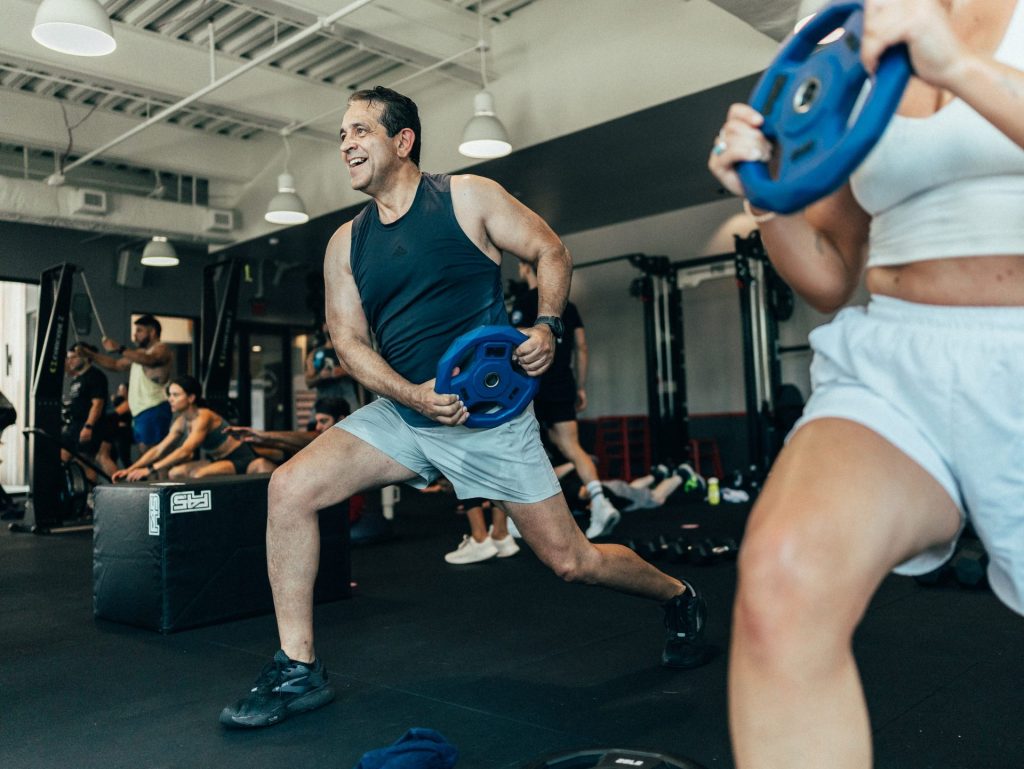It is well-known that muscle training (also known as hypertrophy training) helps to build muscle. Yet, while building muscle is often associated with looking good, research shows it also plays a vital role in feeling good – especially as you get older.
Regular muscle training can help you build and maintain muscle mass, even after 60. And, by better customizing your workouts after 60, you can ensure your muscle training works both with and for your lifestyle – not against it.
Want to know more? Read on, as we explore how you can harness the benefits of muscle training to promote a healthier (and longer) life.
Why muscle training matters for longevity and wellness
Getting older is an inevitable biological process that can’t be avoided – and, while the symptoms of aging are most obvious in the face and hands, it affects our muscles, too.
Age-related gradual muscular atrophy, medically known as sarcopenia, refers to the loss of muscle because of aging, with people aged 60 and older most affected. What’s more, lifestyle also plays a role – and, even aside from aging, the leading causes of muscle loss include physical inactivity, obesity, and not giving your body the protein it needs¹.
Sarcopenia is linked to a litany of health conditions that affect longevity and wellness, such as chronic disease, and the weakening of bones and muscles². Weakened bones and muscles are connected to higher rates of falls and mortality³. Together, this can contribute to a loss of independence – increasing the risk of mental health illnesses in older people4.
So where does F45 come in – and what are the benefits of muscle training?
Top 4 benefits of muscle training
Everyone will experience some muscle loss as they age – that’s the bad news.
The good news, however, is that strength training is the key to building and maintaining muscle – not to mention offsetting and slowing down sarcopenia as you get older. From stronger bones to a stronger mind, we’ve rounded up our top four benefits of muscle training below – and how you can unlock them in one of our group fitness classes at F45.
1. Stronger bones
Bone density decreases with age, making you more predisposed to bone disorders. Regular resistance training, however, is proven to improve bone density and prevent osteoporosis5 – and research suggests that you can achieve results with as little as 60 minutes per week6.
2. Improved mental health
The benefits of muscle training for mental health are well-documented – as are the effects of the mood-boosting endorphins released every time you launch into a challenging workout.
Beyond the stress-relieving, happiness-enhancing role of endorphins, though, muscle training’s advantages can also be more long-term. For example, strength training supports weight loss, which – when coupled with the discipline required to create a sustainable fitness routine and stick to it – enhances self-esteem and overall self-image7.
3. Injury prevention
Another one of the key benefits of muscle training? Fewer injuries.
Why? Because training under load doesn’t just strengthen your muscles – it supports your ligaments, tendons and joints, too,8. Ensuring your muscles are strong is a great way to prevent injury while working out, as well as cut down on other workout-related discomfort: such as back strain or shoulder pain. Muscle training has also been proven to be effective in lowering the risk of falling – particularly in older people9.
4. Functional strength
The benefits of muscle training aren’t limited to the aesthetic or the health-related – they have important implications for your day-to-day life, too.
That’s because lifting weights builds your functional strength. As Dana Point, California-based F45 trainer Cristina Chan explains, “each exercise and workout in a HIIT (High-Intensity Interval Training) or cardio workout at F45 is designed to support activities you do each day, in the everyday rhythms and routines of life. Whether that’s carrying the groceries, walking up a set of stairs, and even playing with your kids and grandkids, the benefits of muscle training include helping you live life – on your own terms.”
Best muscle training exercises for everyday strength- Stronger Than Ever
With the main benefits of muscle training covered off, let’s look at some practical examples.
The following exercises work all the key muscles that promote healthy posture, balance and stability – making them perfect for everyday life, at every stage of life.
We see this represented in so many of our stories represented by Stronger Than Ever. Members from across the globe, 50+ years of age, who discovered new found strength; mentally, physically, and emotionally from beginning their training at F45. Stories ranging from broken bones due to Osteoporosis, to knee and hip surgery, to the challenges that come along with menopause. All of these members had one thing in common, F45.
Nky Iweka from Kensal Green, London states “I don’t want anyone picking things up off the floor for me or helping me put my shoes on when I’m older. I really need to future proof my body, to keep as much independence I can for the rest of my life.” At 55 Nky went from barely being able to walk due to severe injuries in both knees, to now doing full squats. She credits F45 with being a life changer for her.
John Doble of North Langley had total hip replacement surgery, he joined F45 to help with his rehabilitation, to help build strength and regain his balance. He states that after two years, “he’s still getting stronger and that he has not had this type of energy since he was in his 30s.”
Listed below are a few of our favorite exercises to begin building a stronger you.

Lower-body muscle training exercises
Age-related weakness – especially in the legs and stabilizing muscles of the lower body – can increase the risk of falls as we age. So, ensuring those muscle groups in your lower body are strong can vastly improve your quality of life.
Two exercises to help you access the lower-body benefits of muscle training are:
- Squats: one of the best exercises you can do for your lower body, squats work all the muscles in your legs. They’re also versatile – and you can perform them with a barbell, dumbbell, or bodyweight to fit your unique fitness needs and capabilities.
- Deadlifts: these train the glutes, hamstrings, and even your lower back and core.
Both squats and deadlifts are a feature of our hybrid and resistance workouts here at F45. With guidance from our expert trainers and the support of your local community of fitness enthusiasts, our members receive additional support and guidance to ease into exercises that your body might not be familiar with, in order to help avoid injury.
Upper–body muscle training exercises
Maintaining strength in your upper body is just as important, especially as it supports everyday activities like lifting, reaching, showering, and dressing. Strong upper body muscles also contribute to better posture and reduced risk of aches and pains as you age.
To unlock the upper-body benefits of muscle training, try the following exercises:
- Push-ups: an F45 staple, push-ups target the chest, triceps, and shoulders, while also engaging your core. Better still, our trainers can help you scale push-ups to your level – from incline push-ups for beginners to weighted variations for pros.
- Renegade rows: combining a plank hold with a dumbbell row, this exercise strengthens your back, shoulders, and arms – testing your stability and core control.
Want to learn more about how to evolve your muscle training to lift more each week – and keep your body adapting and improving? Check out our guide to progressive overload today.

F45 tips for building a sustainable muscle training routine
At F45, our classes are designed to be inclusive – to welcome people at all levels of ability and fitness, with qualified trainers on hand to walk you through each exercise. We also offer plenty of variety, enabling you to choose the workout – be it cardio, resistance, recovery, or a hybrid session – that suits your needs. Fine-tune your goals with our tips below:
- Start small, start now: kick things off today with some bodyweight exercises – beginning with just 10 minutes a day will help you build the habit.
- Keep it up: you can get stronger with as little as 60 minutes of training a week. Choosing a day or two per week and sticking to it will reap long-term benefits.
- Prioritize recovery: muscle training is one piece of the puzzle. Prioritizing recovery and sleep will ensure you maximize your efforts.
- Stay accountable: F45’s group-based classes invite you into a community of people who love fitness just as much as you do – and will help keep you motivated to train.
Read on to continue discovering the stories from Stronger Than Ever. How members, 50+, from across the globe incorporated F45 into their daily lives, crediting the workout to life altering changes that they never thought possible in this stage of their lives.
Sources:
- https://my.clevelandclinic.org/health/diseases/23167-sarcopenia
- https://theros.org.uk/information-and-support/bone-health/exercise-for-bones/
- https://www.nia.nih.gov/news/how-can-strength-training-build-healthier-bodies-we-age
- https://www.healthdirect.gov.au/older-people-and-mental-health
- https://www.health.harvard.edu/staying-healthy/strength-training-builds-more-than-muscles
- https://pmc.ncbi.nlm.nih.gov/articles/PMC10199130/
- https://www.health.harvard.edu/staying-healthy/exercising-to-relax
- https://pubmed.ncbi.nlm.nih.gov/3633121/
- https://pmc.ncbi.nlm.nih.gov/articles/PMC8304136/














